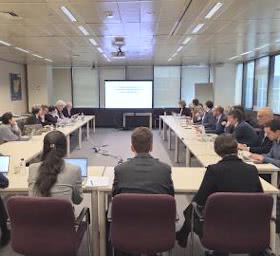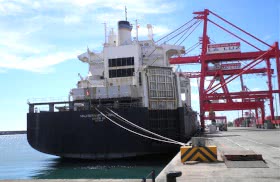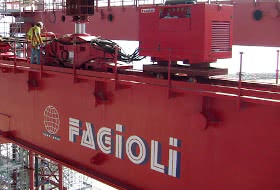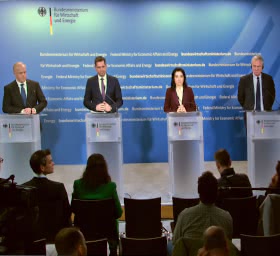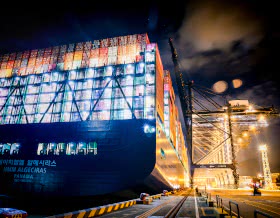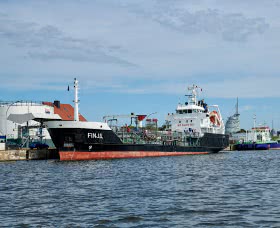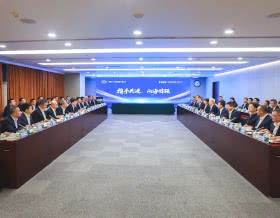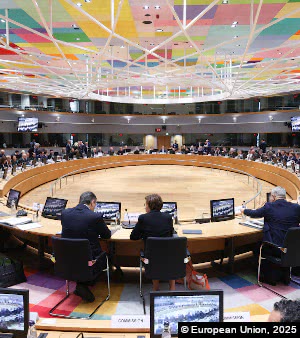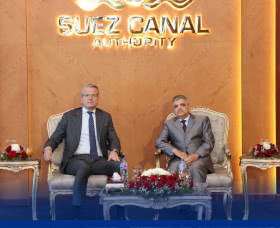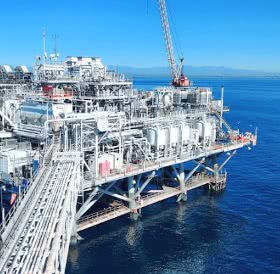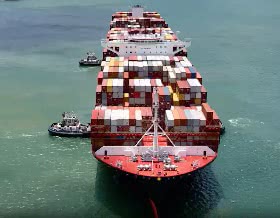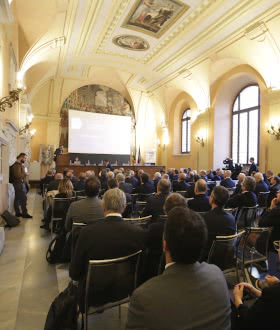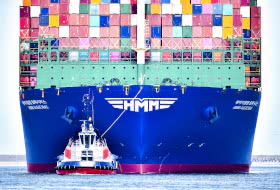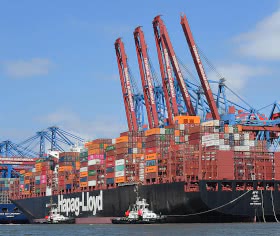Alla fine del 1996 la flotta mercantile mondiale, secondo il Lloyd's
Register, ammontava a 84.264 navi di oltre 100 tonnellate di stazza
lorda (tsl) per un totale di 507,9 milioni di tsl.
Nel corso dell'anno c'è stata una diminuzione per demolizioni
od incidenti per 9,3 milioni di tsl, principalmente tra le petroliere
e le navi adibite al carico generale; vi sono state inoltre nuove
consegne per 25,9 milioni di tsl, il totale più alto registrato
dal 1970 (è da notare come il 68 % di queste sia stato
realizzato in cantieri Giapponesi e della Corea del Sud).
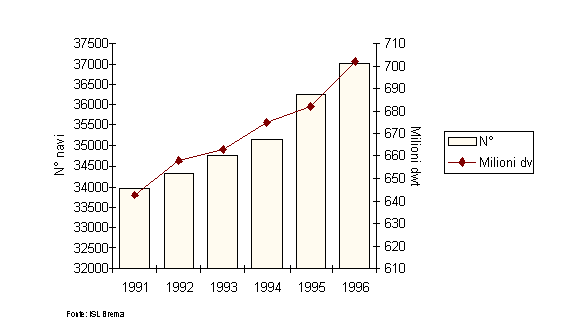
SVILUPPO DELLA FLOTTA MONDIALE
(n° di navi e milioni dwt all'1/1 di
ciascun anno)
Fonte: ISL Brema
Le bandiere di comodo restano leader della flotta mondiale con
Panama al primo posto con 6.105 navi per un totale di 82,1 milioni
di tsl, ovvero il 16,17% della flotta mondiale; nel 1996 il 60
% dell'incremento del tonnellaggio della flotta mondiale è
stato registrato proprio a Panama. Al secondo posto vi è
la Liberia con 60 milioni di tsl (11,81% della flotta mondiale)
ed al terzo la Grecia con 27,5 milioni di tsl (5,42%); l'Italia
è al diciottesimo posto con 6,6 milioni di tsl, pari all'1,3%
della flotta mondiale.
Se analizziamo la flotta mondiale dal punto di vista dell'effettivo
controllo, ovvero se ad ogni paese vengono attribuite le navi
di bandiera nazionale o di convenienza effettivamente controllate,
vediamo che i paesi con registri di convenienza spariscono dalla
lista (di fatto controllano dallo 0 al 2,7% della flotta di bandiera)
e la nazione che controlla la flotta maggiore diventa la Grecia
con il 17,98% della flotta mondiale, seguita dal Giappone (12,93%),
dagli Stati Uniti (7,49%) e dalla Norvegia (7,2%). L'Italia in
questa classifica sale dal 18° al 16° posto, controllando
l'1,71% della flotta mondiale.
E' degno di nota il fatto che più del 50% della flotta
controllata dalle prime 35 nazioni marinare al mondo non è
registrata in quest'ultime, ma in paesi di comodo.
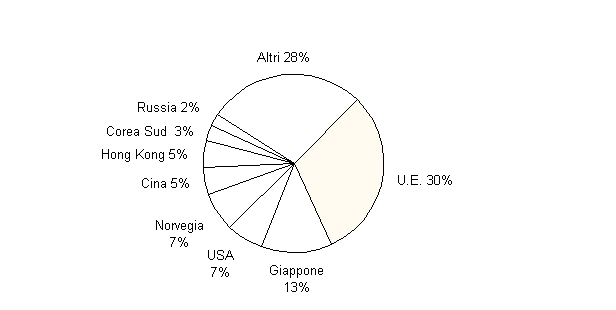
RIPARTIZIONE DELLA FLOTTA MONDIALE
SULLA BASE DELL'EFFETTIVO CONTROLLO
Fonte: elaborazione Confitarma su
dati ISL/LMIS
Nella tabella seguente sono riportate le prime flotte mondiali
per le principali tipologie di navi, considerando l'effettivo
controllo, ed anche la posizione relativa della flotta italiana.
| Passeggeri
(tpl x 1.000)
| Portacontenitori
(tpl x 1.000)
| Cisterne
(tpl x 1.000)
| Portarinfuse
(tpl x 1.000)
|
| 1. Giappone | 573
| 1. Germania |
8.071 | 1. Grecia
| 49.949 | 1. Grecia
| 54.390 |
| 2. Grecia | 472
| 2. Giappone |
4.929 | 2. Stati Uniti
| 35.285 | 2. Giappone
| 40.414 |
| 3. Italia | 443
| 3. Taiwan |
4.672 | 3. Giappone
| 34.269 | 3. Cina
| 19.047 |
| | 19. Italia
| 381 | 13. Italia
| 5.130 | 14. Italia
| 4.108 |
PRINCIPALI FLOTTE MONDIALI PER TIPO DI NAVE
Fonte: ISL Brema
Per quanto riguarda la tipologia delle nuove navi in ordine od
in costruzione presso i cantieri mondiali, il 30% è rappresentato
da bulkcarrier, seguite da portacontenitori (24%) e petroliere
(19%). Notevole è anche l'aumento di navi e traghetti
per passeggeri, che totalizzano 2,7 milioni di tsl (6% del totale)
rispetto ai 2 milioni di tsl di navi da carico generale.
Dal 94 ad oggi le distribuzioni delle varie tipologie di navi
all'interno della flotta mondiale hanno rivelato le seguenti linee
di tendenza: una diminuzione in numero ed in peso percentuale
delle petroliere e portarinfuse polivalenti (ore/bulk/oil), un
aumento in particolare delle portacontenitori, delle bulk carrier
e delle navi passeggeri ed una sostanziale stabilità delle
altre tipologie.
La flotta più giovane è quella giapponese, con un'età
media delle navi di 10 anni, quella più vecchia la greca
con un'età media di 24 anni e le navi da carico statunitensi
con età media 28 anni. L'età media della flotta
mondiale nel 1996 è stata 19 anni, quella della flotta
italiana 22 anni.
Nelle dimensioni medie delle società armatrici, durante
il 1996 e l'inizio del 1997, si sono rilevati notevoli cambiamenti:
lo scenario mondiale è stato caratterizzato da fusioni,
incorporazioni e grandi alleanze fra armatori in molti settori
(trasporto di linea container, dry bulk, crociere).
Queste grandi concentrazioni potranno causare la definitiva crisi
degli armatori di media e piccola dimensione che non riusciranno
a posizionarsi stabilmente in ben definiti mercati di nicchia.
Infatti i grandi gruppi armatoriali, dopo aver potenziato i collegamenti
internazionali iniziano a concentrare la loro attenzione sulle
rotte minori (spesso più redditizie) entrandovi con navi
e servizi dedicati, anche a seguito del surplus di offerta che
inizia ad apparire su alcuni dei mercati tradizionali e che verrà
accentuato con la prossima ondata di consegne di nuove unità.
Analizzando l'order book dei principali 25 paesi costruttori,
a fine giugno 1997, si rileva un netto predominio dei paesi dell'Estremo
Oriente, Giappone al primo posto, seguito nell'ordine da Corea
del Sud e Cina Popolare; la classifica vede quindi la cantieristica
di Germania, Italia e Polonia. E' rilevante il recupero dei cantieri
sudcoreani, il cui order book all'inizio degli anni novanta era
metà di quello dei cantieri giapponesi: alla fine del 1997
probabilmente questo paese raggiungerà il primo posto nella
classifica mondiale.
La costruzione di navi a maggior valore aggiunto, a causa sia
di una più grande complessità di costruzione che
di tecnologie innovative (tra cui ad esempio le navi passeggeri,
alcune tipologie di navi chimiche e cisterna), è comunque
concentrata in cantieri europei, più in particolare in
Italia, Finlandia, Francia, Gran Bretagna, Norvegia e Germania.
La flotta italiana in questi anni ha rivelato un aumento in termini
di tonnellate di stazza, ed una diminuzione in termini di numero
di navi, segno di una crescita della dimensione delle navi armate
da operatori italiani.
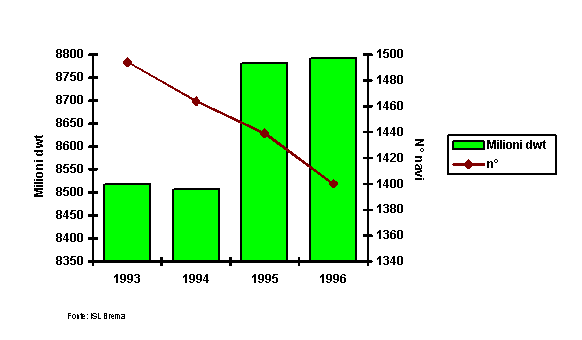
ANDAMENTO DELLA FLOTTA ITALIANA
(n° di navi e milioni di tsl - navi
oltre le 100 tsl)
Fonte: elaborazione Metis da dati
Confitarma
Nella tabella è riportata la distribuzione della flotta
italiana nelle varie tipologie di nave al 1996; il 35% del tonnellaggio
complessivo, pur essendo controllato da armatori italiani, batteva
bandiera estera
| Numero di navi
| Tsl
| Variazione tsl ('95)
|
| Petroliere | 174
| 2.486.675
| - 3,9 %
|
| Chimichiere | 62
| 284.472
| - 3,0 %
|
| Gassiere | 51
| 278.340
| + 11,0 %
|
| Altre cisterne | 42
| 37.870
| - 5,8 %
|
| Portarinfuse (dry b.) |
53 | 1.841.936
| - 1,3 %
|
| Traghetti merci | 54
| 679.049
| + 9,3 %
|
| Portacontenitori | 17
| 467.343
| +12,5 %
|
| Carico generale | 37
| 114.175
| + 14,5 %
|
| Frigorifere | 8
| 102.037
| - 2,9 %
|
| Traghetti passeggeri |
182 | 1.108.548
| + 6,7 %
|
| Crociera | 21
| 591.834
| + 14,4 %
|
| Altre navi passeggeri |
102 | 31.413
| + 3,9 %
|
| Aliscafi, unit. veloci |
69 | 14.563
| + 8,5 %
|
| Rinfuse polivalenti |
2 | 80.615
| - - -
|
| Rimorch. / appoggio |
281 | 95.184
| - 6,1 %
|
| Altre navi | 245
| 578.655
| - 19,7 %
|
| TOTALE | 1.400
| 8.792.709
| + 0,1 %
|
COMPOSIZIONE DELLA FLOTTA ITALIANA AL 31.12.96
Fonte: elaborazione su dati Rina e
Confitarma, navi oltre le 100 tsl
Analizzando la situazione delle società armatoriali italiane
si può notare che, a differenza dei grandi operatori internazionali,
le compagnie italiane sono meno diversificate e globalizzate e
puntano piuttosto al consolidamento od all'espansione della quota
di mercato posseduta nel proprio settore.
Si vede infatti che le grandi società internazionali ricercano
una copertura globale e diversificata del mercato marittimo: per
fare solo degli esempi la P & O è presente nel trasporto
di linea container, nelle crociere, nei traghetti passeggeri,
gestisce bulk carrier, rimorchiatori e navi appoggio per piattaforme;
la Maersk possiede car carrier, navi di linea container, tankers
e gas carrier, bulk carrier, piattaforme di estrazione e navi
appoggio; la Mitsui OSK arma navi portacontenitori, da crociera,
LNG, navi cisterna, car carrier e chimichiere; questa lista può
proseguire oltre, ed in più tutte queste compagnie possiedono
e gestiscono anche terminal portuali di svariate tipologie, società
di trasporto e di logistica integrata.
Nel panorama italiano, eccetto alcuni casi, non si riscontrano
situazioni analoghe a queste, non solo in termini di dimensioni
delle flotte, ma anche dal punto di vista della diversificazione.
E' peraltro da notare come la dimensione dei grandi gruppi internazionali
sia di ordini di grandezza decisamente superiori alle società
italiane per cui queste, non potendo competere globalmente, si
devono assestare su mercati di nicchia e mirano ad espandere o
consolidare queste posizioni.
Come già evidenziato nei dati relativi alla flotta mondiale,
si rileva nei principali paesi industriali una generalizzata tendenza
verso un esodo sempre crescente delle flotte di bandiera verso
registri di paesi in via di sviluppo con particolari condizioni
fiscali e/o normative, ed anche all'interno dell'Unione Europea
questo fenomeno è significativo.
Nella tabella sottostante è evidenziata la percentuale
di flotta registrata presso "open registry" nei principali
paesi europei.
| Numero di navi
| Flotta controllata
(tpl x 1.000)
| Flotta con bandiera estera (%)
|
| 1. Grecia | 2.821
| 114.950
| 60 % |
| 2. Regno Unito | 641
| 20.141
| 80 % |
| 3. Germania | 1.388
| 17.176
| 65 % |
| 4. Svezia | 343
| 13.942
| 85 % |
| 5. Danimarca | 575
| 12.347
| 42 % |
| 6. ITALIA | 546
| 11.064
| 35 % |
| 7. Francia | 217
| 7.578
| 45 % |
| 8. Paesi Bassi | 508
| 5.217
| 39 % |
| 9. Belgio | 137
| 4.077
| 100 %
|
| 10. Finlandia | 153
| 3.372
| 67 % |
| 11. Spagna | 202
| 3.108
| 64 % |
| 12. Portogallo | 43
| 953 |
44 % |
| 13. Austria | 45
| 528 |
75 % |
| 14. Irlanda | 45
| 164 |
21 % |
| 15. Lussemburgo | 6
| 134 |
72 % |
| TOTALE U.E. |
7.670
| 214.751
| 61 %
|
FLOTTA CONTROLLATA DALL'UNIONE EUROPEA AL
31.12.96
Fonte: elaborazione Confitarma su
dati ISL Brema, navi superiori a 1.000 tsl
Per dare una dimensione del fenomeno in Italia si vede che per
le navi oltre le 100 tsl la percentuale con bandiera estera è
salita dal 12,1% del 1993, al 16,1% nel '94, 21,4% nel '95 fino
a raggiungere al 31.12.96 il 24,9%. Se considerando solo le navi
più grandi, ovvero superiori alle 1.000 tsl, questa percentuale
sale dal 24,9% al 35%, segno che la diminuzione dei costi nei
registri esteri è maggiormente significativa al crescere
della dimensione delle navi.
Gli "open registry" più utilizzati dagli armatori
italiani sono nell'ordine: Malta dove è immatricolato il
32,7% della flotta italiana registrata all'estero, le Bahamas
con il 20,5%, la Liberia con 14,5% e Cipro con il 7,5% (fonte:
Lloyd's Maritime Information Service).
Mantenendosi la situazione normativa e fiscale attuale, uno studio
eseguito da Confitarma nel 1996 prevede un forte calo della flotta
nazionale adibita a traffici internazionali, se non addirittura
un rischio di estinzione intorno all'anno 2004.
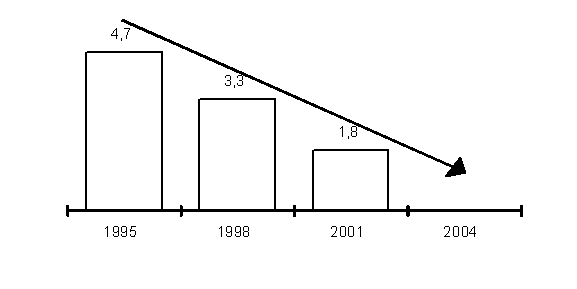
FLOTTA ITALIANA ADIBITA A TRAFFICI INTERNAZIONALI
- PROIEZIONI
(tsl)
Fonte: Confitarma
Secondo Confitarma uno dei motivi alla base della crisi della
navigazione italiana sta nel fatto che le navi con bandiera italiana
devono sopportare costi di gestione sensibilmente superiori rispetto
alle bandiere europee più competitive, per non parlare
dei costi equivalenti in un registro aperto.
Nello studio realizzato si mostra come il maggior costo rispetto,
ad esempio, a Norvegia o Gran Bretagna per la gestione di una
nave portacontenitori od una portarinfuse sia dell'ordine di 2.000
$ USA al giorno. Questi maggiori costi sono attribuibili in gran
parte ai costi del personale, e relativi oneri fiscali.
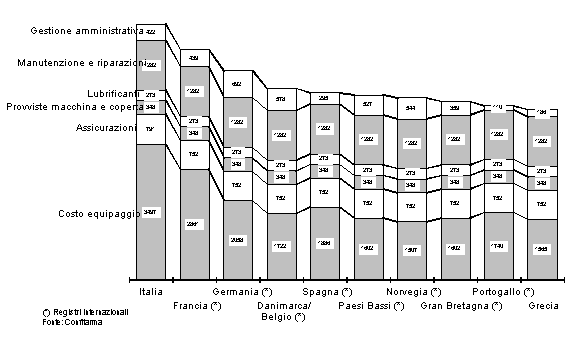
COSTI DI GESTIONE PER DIVERSI PAESI EUROPEI
Fonte: Confitarma
Questi dati hanno un effetto diretti sull'occupazione in questo
settore in Europa: il numero totale di marittimi comunitari imbarcati
su navi battenti bandiera EU è crollato da 215,000 a 139,000
tra il 1985 ed il 1995 (- 35%). Questo declino è avvenuto
in concomitanza con la crescita pari al 15% del numero di marittimi
extracomunitari imbarcati sulle stesse navi, provenienti per la
maggior parte da paesi asiatici.
Bisogna inoltre considerare il fatto che, rispetto ai registri
di paesi in via di sviluppo, i registri nazionali hanno costi
più alti anche per standard tecnici e di sicurezza più
elevati.
La Commissione Europea, riconosciuta l'importanza strategica
dei trasporti marittimi ed analizzate le negative linee di tendenza
della flotta di bandiera comunitaria sopra esposte, sta promuovendo
nuove iniziative atte al rilancio del settore.
Le principali linee guida sono finalizzate a:
neutralizzare i vantaggi competitivi di cui usufruiscono
armatori che operano con standard inferiori;
garantire che i trasporti all'interno della comunità
avvengano in un mercato libero ed in condizioni concorrenziali,
con attenzione alla sicurezza ed alla qualità;
favorire un allentamento della maggior pressione che
gli armatori comunitari devono sopportare in termini di tasse
ed oneri sociali, in modo da ridurne l'esodo verso le bandiere
di convenienza.
A questo fine la Commissione Europea nel 1989 ha proposto l'istituzione
dell'EUROS, registro comunitario parallelo a quelli delle singole
nazioni e che avrebbe dovuto avere costi di gestione paragonabili
a quelli delle bandiere di convenienza. La proposta è
stata però accolta con poca soddisfazione dalla comunità
marittima, che la reputa ancora lontana dalle reali esigenze degli
armatori.
La situazione odierna vede invece un sempre maggiore successo
riscosso dalla creazione, da parte di molti stati membri dell'Unione
Europea, dei registri internazionali, o "registri bis"
che hanno come scopo proprio quello di garantire alle flotte di
bandiera costi di gestione e costi fiscali competitivi rispetto
a quanto viene offerto dai paesi "open registry". Questo
ha consentito un'inversione di tendenza in alcuni paesi membri,
per prime Gran Bretagna e Norvegia (all'ottavo posto nel mondo
per flotta gestita, seconda in Europa solo alla Grecia), ma anche
Danimarca, Pesi Bassi e Francia. Anche in Italia oggi è
in dirittura d'arrivo un legge atta a creare un registro internazionale.
La strategia marittima europea, elaborata da un'apposita commissione,
mira inoltre a promuovere nei prossimi anni:
- maggiore sicurezza del settore,
con un'attenzione particolare non solo ai marittimi imbarcati
su navi comunitarie, ma, attraverso controlli nei porti, su tutte
le navi che scaleranno paesi comunitari;
- incremento della formazione
del settore marittimo in generale e del personale navigante in
particolare, con espliciti riferimenti alle innovazioni tecnologiche
che si stanno via via diffondendo sulle navi;
- salvaguardia degli attuali posti
di lavoro in questo campo, messi oggi in discussione più
che in altri settori;
- introduzione di una cultura
delle qualità nel trasporto marittimo;
- incentivazione della ricerca
e sviluppo nel trasporto marittimo comunitario, per una sua maggiore
competitività (nel periodo 1994-1998 per questo sono stati
stanziati 50 milioni di ECU).
All'interno del quadro della normativa U.E. va inoltre inserita
la politica di progressiva liberalizzazione del cabotaggio:
il cabotaggio aereo ha visto la sua liberalizzazione nel 1997,
quello stradale verrà attuato nel '98 e quello marittimo
nel 1999. Anche per i trasporti ferroviari è allo studio
il libero accesso alle infrastrutture per le imprese intermodali
private (vedere anche l'annotazione relativa al rapporto Kinnock,
nella parte relativa agli operatori ferroviari).







